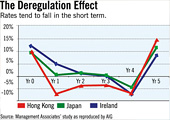 |
"The
industry has not been able to cost-effectively service a huge
market"
Sandeep Bakhshi
MD & CEO/ICICI Lombard |
If
Indians don't seem to care much about insuring their lives, they
care even less about their assets. Or at least that's what the
numbers reveal. Take a look: 99 per cent of the households are
uninsured, and so are 80 per cent of two-wheelers in India, and
only 2 per cent of the total health spends in the country come
via insurance. "It's more a supply side issue rather than
a demand issue. We have not been able to cost-effectively service
a huge market," says Sandeep Bakhshi, MD & CEO, ICICI
Lombard, one of the most aggressive private insurers in general
insurance.
Cost is increasingly becoming a critical
issue in general or non-life insurance. Three crucial portfolios
were de-regulated earlier this year that had a fall-out on the
overall portfolio of non-life companies. Earlier, pricing was
fixed for fire, engineering and motor insurance at levels higher
than commensurate risks. In this scenario, the insurance companies
used to cross-subsidise their loss-making portfolios with those
offering fat margins. But with tariff restrictions gone, a risk-based
pricing, de-linked from other portfolios, was expected to emerge
in the market. While that has happened in some portfolios-like
in the case of health and motor-the immediate impact was expected
to be an over-the-board drop in prices.
On that count, the consumers have not been
disappointed. Rates for fire and engineering covers have dropped
by 25 to 30 per cent. In fact, the price competition has been
so intense that IRDA has had to step in to set a floor level for
the drop in prices. "On a month-to-month basis, discounting
has doubled since February," says Kamesh Goyal, head of Bajaj
Allianz General Insurance, another aggressive insurer in the market.
Industry watchers point out that the pricing pressure is so severe
that in some cases discounts have touched 50-70 per cent as well,
although the overall scenario is still not that bad. "The
Indian market has behaved largely along expected lines and quite
well post-detariffication," says Praveen Vashishta, CEO &
MD, Howden India, an insurance broking firm.
He also points out that the Indian experience
looks quite similar to those of other countries that freed up
general insurance. For example, in countries such as Hong Kong,
Japan and Ireland, the market growth suffered in the first four
years of deregulation, but that was followed by a sharp recovery
in the fifth year (See The Deregulation Effect). That means in
the short term, things will only get worse for general insurers
in the country.
 Hurtful
Competition Hurtful
Competition
While customers may relish the price war
(many of the large ones are flexing muscle to get hefty discounts),
it's not in their interest in the long term-especially, if the
profitability of the insurer gets affected. If the insurer is
not healthy, then the very reason for taking an insurance cover
gets defeated, since a financially precarious insurer may be in
no position to pay claims. "The current price reductions
have no rationale as there is no perceptible drop in risk associated
with those policies," points out G.V. Rao, Chairman GVR Risk
Management Associates. Rao, a former chairman of government-owned
Oriental Insurance, believes that these cuts come from a mentality
of chasing market share at any cost. "In a bad year, with
any unforeseen catastrophe, things could become very, very ugly,"
warns Goyal of Bajaj Allianz.
Notwithstanding these concerns, Goyal expects
the pricing pressures to continue for the next couple of years.
The options are simple: chase growth or profitability. "We
have taken a decision not to focus on topline this year but to
try and defend our market share of around 7.2 per cent,"
says Goyal, adding pragmatically that in portfolios where the
loss ratios are good, the company continues to compete on price.
Otherwise it lets the business go. These pressures are evident
in the latest statistics, where the monthly growth rates of premium
for the companies have dropped to around 10 per cent as compared
to over 20 per cent earlier. This drop is despite the fact that
there has been an increase in the premium of some portfolios such
as motor vehicles.
Retail Focus
 |
"What
we are selling is peace of mind and there is enough buying
power for that"
Ajit Narain
MD & CEO/IFFCO-Tokio General Insurance |
Next April, when the regulator is expected
to completely free pricing and allow changes in policy wordings,
the dynamics of the industry will change further. The prospect
of even stiffer competition has got insurers to consider growing
new lines of business. Since the squeeze on margins is particularly
severe in corporate and commercial lines of business, insurance
companies are now looking to tap retail customers to cushion against
the pricing pressures. Ajit Narain, MD and CEO of IFFCO-Tokio
General Insurance, says that nearly all companies have started
looking at retail portfolios in a big way. IFFCO-Tokio's focus
on retail business itself is such that it requires a 100 per cent
subsidiary purely for retail marketing.
Another move is towards the hinterland or
non-urban India. "Anything that is not categorised as Class
A, B or C cities is interior India for us, and that is a huge
opportunity for us (non-life companies)," says IFFCO-Tokio's
Narain. Already, the share of fire and engineering is going down
in the overall portfolio mix of insurance companies. Further widening
of the portfolio mix and, therefore, risk, makes for sound business
sense. Ultimately it will be back to the basics. Ultimately, "the
core product that insurance companies sell is risk management,"
says Rao. Adds Narain: "What we are selling is peace of mind
and there is enough buying power for that."
What will keep the general insurers going
is the fact that there's plenty of room to grow. Vashishta says
that for non-life business to contribute even 1 per cent of the
GDP, it would need to grow at 30 per cent a year for several years.
Down the road, several other changes may occur. Besides the inevitable
industry consolidation, customers-particularly companies-will
look at insurance from a risk management perspective. After all,
global warming and terrorism are changing the world in unpredictable
ways.
|






 Hurtful
Competition
Hurtful
Competition 